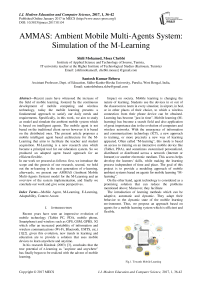AMMAS: Ambient Mobile Multi-Agents System: Simulation of the M-Learning
Автор: Shili Mohamed, Moez Chebbi, Santosh Kumar Behera
Журнал: International Journal of Modern Education and Computer Science (IJMECS) @ijmecs
Статья в выпуске: 1 vol.9, 2017 года.
Бесплатный доступ
Recent years have witnessed the increase of the field of mobile learning, fostered by the continuous development of mobile computing and wireless technology, today the mobile learning presents a fundamental approach to satisfy our daily needs and requirements. Specifically, in this work, we aim to study as model and simulate the ambient mobile system which is based on intelligent agents. The mobile agent is not based on the traditional client server however it is based on the distributed ones. The present article proposes a mobile intelligent agent based architecture for the M-Learning that aims to facilitate the teacher and student acquisition. M-Learning is a new research area which became a principal tool for our education system. So we produced an adapted agent based approach for an efficient flexible. In our work we proceed as follows: first, we introduce the scope and the genesis of our research, second, we hold out the m-learning is the next generation of e-learning, afterwards, we present our AMMAS (Ambient Mobile Multi-Agents System) model for the M-Learning and an overview of the system implementation, and finally we conclude our work and give some perspectives.
Mobile Agent, M-Learning, E-Learning, Adaptability, Context Aware
Короткий адрес: https://sciup.org/15014936
IDR: 15014936
Текст научной статьи AMMAS: Ambient Mobile Multi-Agents System: Simulation of the M-Learning
Published Online January 2017 in MECS DOI: 10.5815/ijmecs.2017.01.04
Recent years have seen an impressive evolution of mobile technology (Tablet PC, PDA, mobile phone, Smartphone) and wireless such as GPS, GSM, GPRS, 3G which offer an increased portability of information and wireless communications (Wi-Fi, Bluetooth, UMTS, etc.) [1][2]. given this evolution, new trends in learning and education are to provide a solution that uses mobile devices to learn anywhere and anytime.
In his research Kinshuk (2003) [3], concludes that the true potential of e-learning as "anytime and anywhere" has finally begun to be realized with the advent of mobile learning.
Impact on society. Mobile learning is changing the nature of learning. Students use the devices in or out of the classroom to learn in every situation; in airport, in bed, or in other places of their choice, to which a wireless connection from their phone device can be obtained. Learning has become "just in time". Mobile learning (M-learning) has become a search field and also application of great importance due to the evolution of computers and wireless networks. With the emergence of information and communications technology (ICT), a new approach to training, or more precisely a new way of learning appeared. Often called "M-learning", this mode is based on access to training on an interactive mobile device like (Tablet, PDA), and sometimes customized personalized, distributed or distributed across a network (Internet or Intranet) or another electronic medium. This access helps develop the learners' skills, while making the learning process independent of time and place. The goal of this project is to provide a modeling approach of mobile ambient systems based on agents for mobile learning “M-learning”.
On the other hand, agent technology is considered as a promising solution that can reduce the problems mentioned above; Moreover, they facilitate
The introduction of learning methods which can be adaptive, automatic and dynamic. They adapt their behavior to the dynamic state of the mobile learning environment. Thus, we propose an approach based on agents for a mobile learning system which is efficient and flexible.
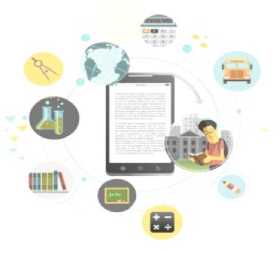
Fig.1. Towards Mobile Learning
In modern life, people begin to use mobile devices in learning to achieve their goals in terms of time and place. Our goal is to improve the quality of learning by providing the learner a customized educational path suited to adapt to its achievements, skills and needs.
In the following sections, we will present: first the historical of mobile learning, second the proposed approach, third our contribution, fourth the experimental results, afterwards the conclusion, and finally some perspectives.
-
II. Definition
-
A. E-Learning
To explain the concept of M-Learning, it is necessary to talk about the E-Learning concept. The E-Learning is a teaching and learning method based on Internet. The name is an abbreviation of the term "Electronic Learning". With this method, we can speak about a distance education without the need for face meetings or having to go to class. This is possible thanks to the facilities that the Internet gives us [4].
The E-Learning offers advantages such as:
-
• The student doesn’t have to go to class; he can take the course from home.
-
• Internet gives us many methods and resources which facilitate learning.
-
• The student is the focus of the learning process, and participates in the construction of knowledge.
-
• Now the teacher is not only a transmitter of knowledge, he is a coach that should help students in their learning process.
-
• Immediate update featuring Internet allows the student always has an updated education.
-
• The constant communication between the participants of this process.
Once we have seen the concept of E-Learning, we can talk about the M-Learning [5].
-
B. M-Learning (Mobile learning)
Since the emergence of M-learning, a number of definitions were given in the literature of M-Learning. It is very difficult to give to it a single definition. Thus, we browse below quickly some definitions in the literature to see if we can find a consensus.
The advent of mobile technology in our lives is an unstoppable reality social and economic, which exceeds the educational and cultural spheres. This incorporation changes the social and educational environment and we must incorporate it to the processes of learning and teaching.
The M-Learning or Mobile learning has been defined for several experts in this area. Some definitions are [5]:
According to Quinn (2000), the M-Learning or Mobile Learning, is the same as the E-Learning with the difference that the M-Learning is through portable devices with Internet access. These devices can be Smartphone, table PC, laptop's, portable computer... Quinn thinks that the Mobile Learning is an extension of the E-Learning but the M-Learning offers independence of space and time. With this we can get Internet access all day from anywhere.
Harris (2001) defines the Mobile Learning as “the point at which the mobile computing and E-learning are intercepted to produce a learning experience anytime, anywhere. According to him the mobile Learning includes the use of mobile phone, PDA... anything that allows the user to access to the course resources wherever he is.”
“Mobile learning is an emerging paradigm in a state of intense development driven by the confluence of three technology flows, ambient computing power, communication and development environment for user’s intelligent interfaces.” Sharples (2002). “M-Learning is the acquisition of any knowledge and skills through the use of mobile technology at any time and place" Geddes (2009).
-
III. E-Learning Vs M-Learning
Table 1. Terminology Comparison of E-learning and mobile learning (according to Sharma and Kitchen, 2004 [6])
|
E-learning |
M-learning |
|
Computer |
Mobile |
|
Bandwidth |
GPRS, G3, Bluetooth |
|
Multimedia |
Objects |
|
Interactive |
Spontaneous |
|
Hyperlinked |
Connected |
|
Distance learning |
Situated learning |
|
Collaborative |
Networked |
Here is a more detailed diagram.
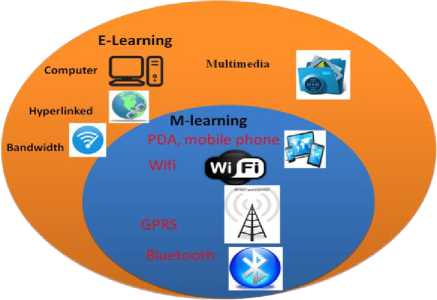
Fig.2. Terminology Comparison of E-learning and M-learning
-
IV. Mobile Learning Features
According to ANANI and al. [7] « As M-learning is a particular kind of E-learning, it also has the same features as the E-learning ». So, in a situation type of M-Learning, we find the same features as in a situation type of ELearning or distance learning [8]:
-
• Actors: the training situation actors, teachers, learners, tutors.
-
• Educational content: educational content, its eventual materialization, as in the case of practical work. It is eventual network accessibility.
-
• Pedagogy: explicit teaching guidelines or underlying device constructivism, collaborative learning, contextual, located ...)
-
• Multicultural: different countries or cultures from which the actors, the languages used to communicate.
-
• Time: The moments when learning takes place.
-
• Synchronous / Asynchronous communication: synchronous activities (several connected actors interacting at the same time) and asynchronous.
-
• Application Type: course, quiz, lab, Project, reviewing, interactive amphitheater, « Just-in-Time learning » …
•Facilities: computer equipment used. In addition to these "classic" features define additional features for an M-learning situation which are:
-
• Mobility:
We distinguish four types of mobility according to whom or what it applies:
An actor (teacher, learner,) If one of the actors is mobile, we speak of " nomadisme " ;
A nomadic person is a person who physically moves from one place to another. The training action will occur either during movement or at displacement points of departure and / or arrival;
A place (of the teacher, of the learner ...) the place in which is one of the training actors is mobile, for example the actor is on a bus;
The device: the device is equipped with an actor is mobile
Educational content
-
• Devices: We distinguish four types of devices:
Fixed: not moved, still connected, no autonomy problem. (e.g desktop computer);
Portable: portable, has autonomy, not permanently connected by a wire connection or wireless (WIFI). (E.g. laptop);
Mobile: Lightweight, the connection may be nearly permanent. (PDA, mobile phone, Tablet PC);
-
V. Methodology
M-Learning systems are based on the mobility that requires a dynamic change of context. Thus, context sensitivity becomes a very important issue in this field.
A context sensitive system must be able to detect the situation and adapt accordingly any system behavior to the situation in question: Its services, its data and its user interface, etc. without explicit user intervention [9].
The Human Machine Interface (HMI) adaptation is the ability to adapt to the context of use in respect of its usability.
-
• The overall objectives of our paper:
V Better interactional efficiency
-
V Improving system availability.
V Progress in the system usability.
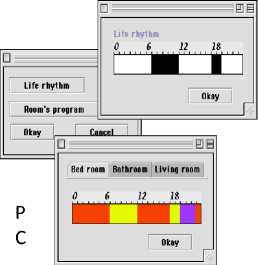
Fig.3. HMI Adaptation
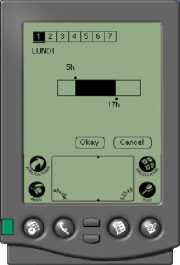
For this, we used the agent technology that offers the possibility of adapting an application using coordination among agents [10].
The agent technology appears an attractive paradigm for developing M-Learning systems. In this case the displacement of the application is made using a mobile agent.
-
A. Mobile agent
Mobile agent able of moving in the network or in the system architecture. [11]
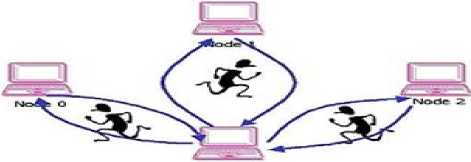
Fig.4. Mobile Agent
-
VI . The Proposed System
Our system offers the possibility of moving the application between different devices with an adaptation of the user interface according to the future context.
-
• It is a learning system based on agents.
-
• The pedagogic agent can move in networks.
-
• The pedagogic agent adapts its user interface according to the future context.
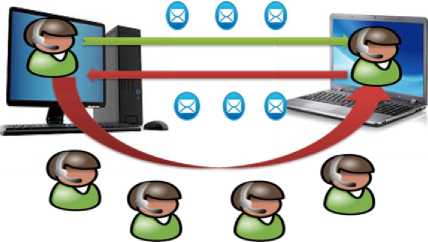
Fig.6. Adapting agents
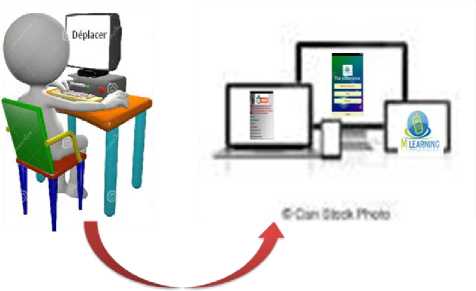
Fig.5. Application displacement
VII. Different Types of Agents in Our System The main agents that constitute our system are:
The communication before the move is necessary for adaptation.
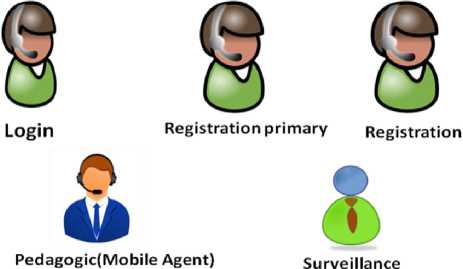
Fig.7. The agents used in our system
Adaptability is conducted with the links in the system pages which must be customized and adapted to the learning style and preferences of the learner.
-The approach proposed in this paper is to design and develop a mobile ambient system based on multi-agent systems for Mobile Learning (M-learning). In our approach, a student can connect via mobile devices, as a PDA (Personal Digital Assistant) or a mobile phone or Smartphone to follow the course that meets their preferences. When connecting to the M-Learning system, the student receives notifications about courses added according to his preferences; he can view his profile and test his knowledge with an evaluation test like quiz. The purpose of our paper is to improve the effectiveness of training and organizing the educational process by providing the learner has a personalized course adapt its characteristics.
The purpose of our paper is to improve the effectiveness of training and organize the educational process by offering to the student a customized program adapted to its features. We will use mobile agents because they are able to seek information in a smarter way. In addition, they are able to communicate and cooperate with each other, which accelerate and facilitate the search. Our proposal is to adapt a learning path to the need of the learner by making it more responsive as possible to its location and profile.
-
VIII. Architecture of Our System
Figure 8 illustrates the detailed architecture of our AMMAS system
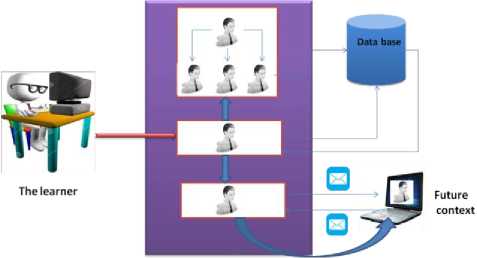
Fig.8. M-Learning System
-
A. general system architecture description
In our paper, we have proposed architecture based on a set of agents; the system will allow the registration of future system users (learners) as well as access to it.
Once the user has access to the system, an pedagogic agent (mobile) will be created to present course to the learner, the system provides the ability to move the application and continue training in an another machine. The application (pedagogic agent), before moving, will know his future context, and it adapts to their features and capabilities without the intervention of the learner who remains focused on his training and finds the user comfort even on different machines.
After registration and user authentication, application starts to present the course. Once the user wants to change a device, he will choose his destination and pedagogic agent (mobile) communicates with the monitoring agent which is in the target machine. This last retrieve the screen resolution and send the information to the mobile agent. According to the information received, the pedagogic agent adapts its presentation window (user interface) under the future context and moves.
-
(1) The learner accesses the system.
-
(2) If he has not an account, his must access to the registration page.
-
(3) After checking the fields, the main registration agent creates the registration agent.
-
(4) When the learner is authenticated, the authentication agent accesses the database to verify the data entered by the learner.
-
(5) Once the student is authenticated, a pedagogic agent starts to view the course.
-
(6) If the student wants to change his machine, he must choose his destination; pedagogic agent contacts the monitoring agent of the destination machine to inform it about the new context.
-
(7) The surveillance agent sends the necessary information to the pedagogic agent.
-
(8) The pedagogic agent adapts according to data information, and it moves to the destination machine.
-
IX. Use Case Diagram
• The learner activities in our system
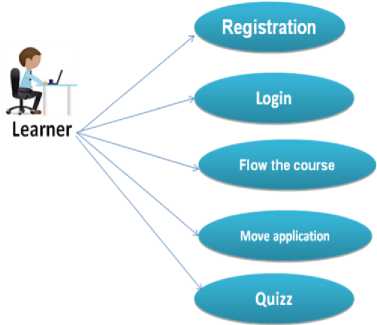
Fig.9. AAMMS M-Learning use case
Our main goal is to provide the proper educational environment at the desired time and in the right way.
-
X. System Implementation
We have implemented a simple prototype to evaluate the concepts proposed in our architecture, using the Java programming language.
-
A. The Development Environment
-
1. Jade-LEAP platform
-
2. Eclipse
-
3. Android
-
4. Interface system
We used the JADE-LEAP (Lightweight and Extensible Agent Platform) platform which is an extension of the JADE platform that can be deployed not only on PCs and servers, but also on devices with limited resources such as compatible Java mobile phones. [12]
Eclipse is an integrated development environment (IDE) for the Java language, even if due to a plug in system, it can also be used with other programming languages, including C/C++ and PHP.
Android is a mobile operating system based on the open source Linux kernel and currently being developed by Google. The system was initially designed for touch Smartphones and tablets, and has specialized in objects such as connected TVs (Android TV), cars (Android Auto) and smartwatch (Android Wear) [13].
To realize and validate our proposals, a prototype is developed, designed for the university community students. In this section, we illustrate some interfaces of the application which we have developed. This application is an implementation of the proposal in the previous section. The following figures show various interfaces of the mobile device corresponding to the scenarios described in the previous chapter: authentication, registration, courses launch (Followed courses) and multiple choice test (evaluation Learner), the test is a set of multiple choice questions on the acquired knowledge in this course section, this test is adapted depending on level, style and profile of the learner.
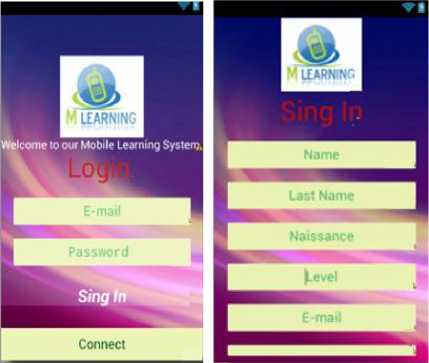
Fig.10. the authentication and Registration page print screen
When the learner starts the application on your mobile device, the home page is displayed, and two orders "Sign in" for registration and "Login" to "connect". If the learner is new, he must choose to "register". So, he must fill in all the registration fields (identification, password, phone number, age, email), and the registration window is displayed as shown in Figure 10.
If the learner is already enrolled in the system, he must choose to "connect". Then, he must complete the two fields displayed by the Tutor agent ("Username" and "Password").
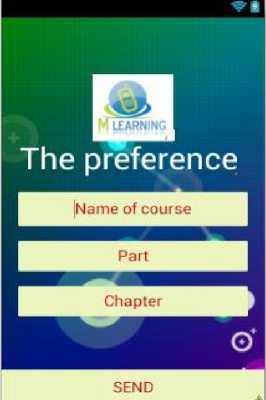
Fig.11. The preference page print Screen
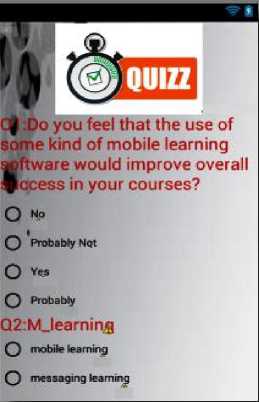
Fig.12. The Quiz page print Screen
Figure 12 illustrates shows a distributed (course, test (quiz) wireless M-Learning environment.
The message traffic checking between our platforms agents is made using the graphical tool offered by JADE which allows viewing exchanged messages in the system (figure 13).
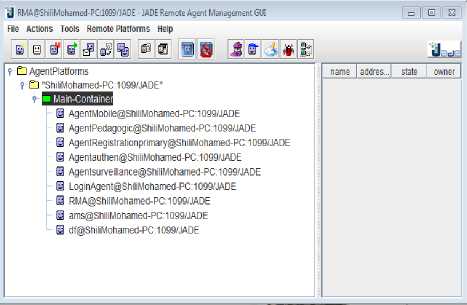
Fig.13. The agents in Jade Platform
-
XI. Conclusion
Список литературы AMMAS: Ambient Mobile Multi-Agents System: Simulation of the M-Learning
- Chouchane Khamsa and Okba Kazar, "Mobile Learning: A State Of The Art And Perspectives", proceedings of the 5th. International Conference on Information Systems and Economic Intelligence (SIIE'12), Djerba, Tunisia, ISBN 9978-9973868- 19-0, Pp. 50-55. February 16 - 18, 2012.
- Chouchane Khamsa, Okba Kazar and Ahmed Aloui, "Agent-based Approach for Mobile Learning using Jade-LEAP", ICWIT'12 (International Conference on Web and Information Technologies), CEUR Workshop Proceeding, Pp. 300-305, CEURWS.org, April 29-30, 2012.
- Kinshuk, "Adaptive Mobile Learning Technologies", Global Educator, Department Of Information Systems Massey University, New Zealand, 2003.
- Giuseppe Laria, Mobile and nomadic user in e-learning: the Akogrimo case, sixth framework programme, Information Society, Fisciano, Italy, 2002.
- MOBILE LEARNING In School and Adult Education IVÁN CEPERO BARMÓN Universidad de Granada.
- Georgiev, S, Georgieva, E, Smrikarov, A, "M-Learning – A New Stage Of ELearning", Proceedings Of The 5th Intern. Conference On Computer Systems And Technologies – Compsys Tech'2004, Rousse, Bulgaria, Pp. Iv.28-1-5, 2004.
- Wang Y. K. Context Awareness and Adaptation in Mobile Learning. Proceedings - 2nd IEEE International Workshop on Wireless and Mobile Technologies in Education; (WMTE'04), Pp. 154-158. 2004.
- Cécile Meyer, et al., M-Learning : Vers une Caractérisation des Situations Pédagogiques, TICE 2006:Technologies de l'Information et de la Communication dans l'Enseignement Supérieur et l'Entreprise. Toulouse; 2006.
- Chuantao YIN, SAMCCO : un Système d'Apprentissage Mobile Contextuel et Collaboratif dans des Situations Professionnelles, Thèse Pour obtenir le grade de Docteur de l'Ecole Centrale de Lyon, Ecole Doctorale Informatique et Mathématiques Lyon, 25 Janvier 2010
- Antti Syvänen et al, Supporting Pervasive Learning Environments: Adaptability and Context Awareness in Mobile Learning.
- Wilhelm., U. G. (2005). "Cryptographically Protected Objects". Retrieved from http://lsewww.ep.ch/ wilhelm/Papers/CryPO.ps.gz.
- Bellifemine, F. & Caire, G. & Greenwood D. Developing Multi-Agent Systems with JADE, John Wiley & Sons Ltd, 978-0-470-05747-6, England. Pp. 145-161. 2007.
- Sarra, R. A. (2013 ). Conception et développement d'une application mobile de vente flash sous android. Tunis ESSECT : mémoire de projet fin d'étude.

